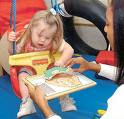
How to Treat Down Syndrome With Physical Therapy?
The goal of physical therapy in Down Syndrome is to help the child learn to move his body in appropriate ways.Use physical therapy to teach a child to move, sit and walk properly.So the goal of physical therapy is to teach proper physical movement.For example, hypotonia in a child with Down Syndrome may cause him to walk in a way that is not posturally correct.Because there are several levels of severity in the symptoms of Down syndrome, an early consultation with a physical therapist can help you determine when to get started and what type of therapy is needed to best help your child.
This can lead to problems, such as pain, in the future.Down syndrome children learn to walk later than other children and need help developing muscle strength and coordination to make the process easier.Physical therapy can be used to treat Down syndrome children, especially at a later age, when the basic skills have already been learned.
This is called compensation.Without physical therapy many, if not most, children who have Down Syndrome will adjust their movements to compensate for their low muscle tone.Sitting, rolling over and jumping or climbing also require practice through special exercises that a physical therapist can especially design.
The Opportunity of Physical Therapy
But there is actually an opportunity beyond the development of motor skills of which parents may wish to take advantage while their child is receiving physical therapy.They have a different style of assimilating information, and therefore, the usual methods of instruction are less effective.If physical therapy has achieved the goal of minimizing the development of abnormal movement patterns, it will have influenced the health of the child with Down Syndrome throughout the course of his or her life.The opportunity is for parents to use the arena of gross motor development to begin to understand how their child learns.There are many other challenges to come including language, education, and the development of social skills, but learning gross motor skills is the first developmental challenge.
There is mounting evidence that children with Down Syndrome do not learn in the same manner that typical children do.The development of gross motor skills is the first learning task that the child with Down Syndrome and his parents face together.Knowing how to facilitate their child's learning will be critical to their success in collaborating with their child throughout his or her lifetime.
Wishart (1991),a psychologist at the University of Edinburgh in Scotland, has done leading edge work in studying how children with DS learn. She writes:
Despite the absence of an adequate developmental database, theory and practice in this area have nonetheless continued to assume that the process of learning in children with Down syndrome is essentially a slowed-down version of normal cognitive development. An increasing number of recent studies are suggesting that this 'slow development' approach may be ill founded and that learning may differe significantly in structure and organization from that found in ordinary children...
Infants with Down syndrome consistently showed evidence of underperforming, with avoidance routines being produced on many of the tasks presented, regardless of whether these were above or below the infant's current developmental level. New skills, even once mastered, proved to be inadequately consolidate, often disappearing from the infant's repetoire in subseequent months. Follow-up studies using a wider range of tasks proved additional evidence of this tendency to 'switch out' of cognitive tasks, with many children failing on items which should have been within their capabilities and which had ben passed in earlier sessions...
Regardless of whether these irregular performance profiles reflect genuine developmental instability or are the result of fluctuating motivation in assessment-type situations, it remains that if test behaviour is typical of behaviour in other, everyday situations, development itself must be compromised.
Therefore, it is very important the physical therapist is trained and knowledgeable in the ways in which children with Down Syndrome tend to compensate for their low muscle tone, loose joints, and other musculoskeletal differences.
How can early intervention benefit a baby?
Physical therapy focuses on motor development.
However, they will achieve each of the same milestones as other children, just on their own timetable.Each type of early intervention addresses specific aspects of a baby’s development.Appropriate physical therapy may assist a baby with Down syndrome, who may have low muscle tone, in achieving this milestone.Most children are expected to achieve each milestone at a designated time, also referred to as a “key age,” which can be calculated in terms of weeks, months or years.
For example, during the first three to four months of life, an infant is expected to gain head control and the ability to pull to a sitting positions (with help) with no head lags and enough strength in the upper torso to maintain an erect posture.Development is a continuous process that begins at conception and proceeds stage by stage in an orderly sequence.Because of specific challenges associated with Down syndrome, babies will likely experience delays in certain areas of development.There are specific milestones in each of the four areas of development (gross and fine motor abilities, language skills, social development and self-help skills) that serve as prerequisites for the stages that follow.In monitoring the development of a child with Down syndrome, it is more useful to look at the sequence of milestones achieved, rather than the age at which the milestone is reached.
Reference:
http://www.ds-health.com/physther.htm
http://www.ndss.org/index.php?option=com_content&view=article&id=221:early-in
http://www.about-down-syndrome.com/index.html

